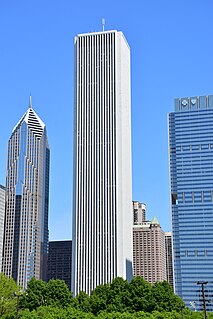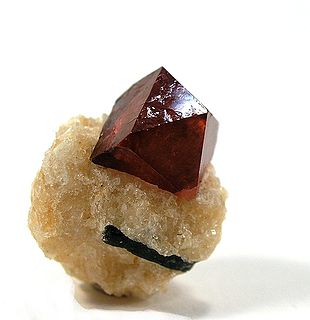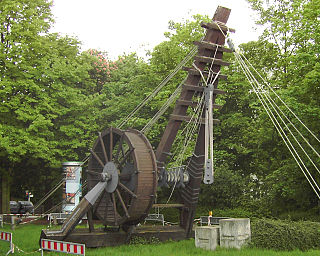Related Research Articles

Granite is a coarse-grained igneous rock composed mostly of quartz, alkali feldspar, and plagioclase. It forms from magma with a high content of silica and alkali metal oxides that slowly cools and solidifies underground. It is common in the Earth's continental crust, where it is found in various kinds of igneous intrusions. These range in size from dikes only a few inches across to batholiths exposed over hundreds of square kilometers.

Marble is a metamorphic rock composed of recrystallized carbonate minerals, most commonly calcite or dolomite. Marble is typically not foliated, although there are exceptions. In geology, the term marble refers to metamorphosed limestone, but its use in stonemasonry more broadly encompasses unmetamorphosed limestone. Marble is commonly used for sculpture and as a building material.

Mining is the extraction of valuable minerals or other geological materials from the Earth, usually from an ore body, lode, vein, seam, reef, or placer deposit. These deposits form a mineralized commodity that is of economic interest to the miner.

Topaz is a silicate mineral of aluminium and fluorine with the chemical formula Al2SiO4(F, OH)2. It is used as a gemstone in jewelry and other adornments. Topaz in its natural state is a golden brown to yellow. A variety of impurities and treatments may make topaz wine red, pale gray, reddish-orange, pale green, pink, or opaque.

The Aon Center is a modern supertall skyscraper just east of the Chicago Loop, Chicago, Illinois, United States, designed by architect firms Edward Durell Stone and The Perkins and Will partnership, and completed in 1974 as the Standard Oil Building. With 83 floors and a height of 1,136 feet (346 m), it is the fourth-tallest building in Chicago, surpassed in height by Willis Tower, Trump International Hotel and Tower, and St Regis Chicago.

Lapis lazuli, or lapis for short, is a deep-blue metamorphic rock used as a semi-precious stone that has been prized since antiquity for its intense color.

Zircon ( or ) is a mineral belonging to the group of nesosilicates and is a source of the metal zirconium. Its chemical name is zirconium silicate, and its corresponding chemical formula is ZrSiO4. A common empirical formula showing some of the range of substitution in zircon is (Zr1–y, REEy)(SiO4)1–x(OH)4x–y. Zircon forms in silicate melts with large proportions of high field strength incompatible elements. For example, hafnium is almost always present in quantities ranging from 1 to 4%. The crystal structure of zircon is tetragonal crystal system. The natural color of zircon varies between colorless, yellow-golden, red, brown, blue and green.

Cinnabar or cinnabarite, likely deriving from the Ancient Greek: κιννάβαρι, is the bright scarlet to brick-red form of mercury(II) sulfide (HgS). It is the most common source ore for refining elemental mercury, and is the historic source for the brilliant red or scarlet pigment termed vermilion and associated red mercury pigments.

A rock is any naturally occurring solid mass or aggregate of minerals or mineraloid matter. It is categorized by the minerals included, its chemical composition and the way in which it is formed. Rocks form the Earth's outer solid layer, the crust, and most of its interior, except for the liquid outer core and pockets of magma in the asthenosphere.

Open-pit mining, also known as mega-mining, open-cast or open cut mining, is a surface mining technique of extracting rock or minerals from the earth by their removal from an open-air pit, sometimes known as a borrow.
The Pilbara is a large, dry, thinly populated region in the north of Western Australia. It is known for its Aboriginal peoples; its ancient landscapes; the red earth; and its vast mineral deposits, in particular iron ore. It is also a global biodiversity hotspot for subterranean fauna.

Dimension stone is natural stone or rock that has been selected and finished to specific sizes or shapes. Color, texture and pattern, and surface finish of the stone are also normal requirements. Another important selection criterion is durability: the time measure of the ability of dimension stone to endure and to maintain its essential and distinctive characteristics of strength, resistance to decay, and appearance.

The ancient Romans were famous for their advanced engineering accomplishments. Technology for bringing running water into cities was developed in the east, but transformed by the Romans into a technology inconceivable in Greece. The architecture used in Rome was strongly influenced by Greek and Etruscan sources.

Mining in Cornwall and Devon, in the southwest of England, began in the early Bronze Age, around 2150 BC. Tin, and later copper, were the most commonly extracted metals. Some tin mining continued long after the mining of other metals had become unprofitable, but ended in the late 20th century. In 2021, it was announced that a new mine was extracting battery-grade lithium carbonate, more than 20 years after the closure of the last South Crofty tin mine in Cornwall in 1998.

India possesses a wide spectrum of dimensional stones that include granite, marble, sandstone, limestone, slate, and quartzite, in various parts of the country.

Construction aggregate, or simply aggregate, is a broad category of coarse- to medium-grained particulate material used in construction, including sand, gravel, crushed stone, slag, recycled concrete and geosynthetic aggregates. Aggregates are the most mined materials in the world. Aggregates are a component of composite materials such as concrete and asphalt concrete; the aggregate serves as reinforcement to add strength to the overall composite material. Due to the relatively high hydraulic conductivity value as compared to most soils, aggregates are widely used in drainage applications such as foundation and French drains, septic drain fields, retaining wall drains, and roadside edge drains. Aggregates are also used as base material under foundations, roads, and railroads. In other words, aggregates are used as a stable foundation or road/rail base with predictable, uniform properties, or as a low-cost extender that binds with more expensive cement or asphalt to form concrete.

Crushed stone or angular rock is a form of construction aggregate, typically produced by mining a suitable rock deposit and breaking the removed rock down to the desired size using crushers. It is distinct from gravel which is produced by natural processes of weathering and erosion, and typically has a more rounded shape.

Mining in Egypt has had a long history that dates back to predynastic times. Active mining began in Egypt around 3000 BCE. Egypt has substantial mineral resources, including 48 million tons of tantalite, 50 million tons of coal, and an estimated 6.7 million ounces of gold in the Eastern Desert. The total real value of minerals mined was about £E102 million (US$18.7 million) in 1986, up from £E60 million (US$11 million) in 1981. The chief minerals in terms of volume output were iron ore, phosphates, and salt. The quantities produced in 1986 were estimated at 2,048, 1,310, and 1,233 tons, respectively, compared with 2,139, 691, and 883 tons in 1981. In addition, minor amounts of asbestos (313 tons) and quartz (19 tons) were mined in 1986. Preliminary exploration in Sinai indicated the presence of zinc, tin, lead, and copper deposits. Private sector exploration and exploitation activities so far have been limited. Only recently, AngloGold Ashanti with its joint Venture Partner Thani Dubai and a Canadian listed exploration company, Alexander Nubia International have been undertaking exploration in Egypt's Eastern Desert with some success. Centamin Ltd., a mineral exploration company founded in Australia, started a massive mining project in Sukari Hill.

Tajikistan has rich deposits of gold, silver, and antimony. The largest silver deposits are in Sughd Province, where Tajikistan's largest gold mining operation also is located. Russia's Norilsk nickel company has explored a large new silver deposit at Bolshoy Kanimansur. More than 400 mineral deposits of some 70 different minerals have been discovered in Tajikistan, including strontium, tungsten, molybdenum, bismuth, salt, lead, zinc, fluorspar, and mercury. These minerals have been found suitable for mining. Uranium, an important mineral in the Soviet era, remains in some quantity but is no longer extracted. The Tajikistan Aluminium Company (TALCO), an aluminium smelter, is the country's only large-scale production enterprise in the mining sector. Tajikistan hosts the annual Mining World Tajikistan, an international exhibition on mining in Dushanbe.
References
- ↑ Alfred J. Andrea; Kevin McGeough; William E. Mierse; Mark Aldenderfer; Carolyn Neel (28 February 2011). World History Encyclopedia. ABC-CLIO. p. 145. ISBN 978-1-85109-929-0.
- ↑ Nelson L. Nemerow (27 January 2009). Environmental Engineering: Environmental Health and Safety for Municipal Infrastructure, Land Use and Planning, and Industry. John Wiley & Sons. p. 40. ISBN 978-0-470-08305-5.
- ↑ John J. McKetta Jr (14 November 1995). Encyclopedia of Chemical Processing and Design: Volume 54 – Steam Reforming: Operating Experience to Storage Tank Explosion Safeguards. CRC Press. p. 281. ISBN 978-0-8247-2605-8.